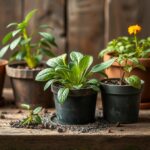Why are the leaves on my money tree turning brown and falling off? Common Causes and Solutions Explained

The money tree, or Pachira aquatica, is a popular houseplant known for its lush green leaves and resilience. However, many plant enthusiasts often face the puzzling issue of brown leaves and leaf drop. Understanding the causes behind these symptoms is crucial for maintaining a healthy money tree. This article will explore the common factors that lead to browning leaves and shedding, ranging from environmental stressors to care practices. By identifying these issues and implementing effective solutions, you can revive your money tree and ensure it thrives in your home for years to come.
Why Are the Leaves on My Money Tree Turning Brown and Falling Off?
The browning and shedding of leaves on your money tree can be attributed to several factors, including improper watering, lack of humidity, and pest infestations. Money trees thrive in consistent moisture; overwatering can lead to root rot, while underwatering can cause stress, leading to brown tips and leaf drop. Additionally, these plants prefer higher humidity levels, so dry air can cause the leaves to brown at the edges and fall off. Regularly checking for pests such as spider mites or scale insects is also essential, as they can damage the plant and result in leaf loss.
Improper Watering Techniques
Improper watering techniques are one of the most common reasons for a money tree's leaves turning brown. Both overwatering and underwatering can stress the plant, leading to undesirable symptoms. Overwatering can cause root rot, which inhibits the plant's ability to absorb water and nutrients, leading to yellowing and browning leaves. Conversely, underwatering can cause the leaves to dry out, leading to brown edges before they eventually drop. Consistently watering the plant when the top inch of soil feels dry can help avoid these issues.
Lack of Humidity
A lack of humidity is another significant reason for browning leaves on a money tree. These plants are native to tropical climates, where humidity levels are typically high. In dry indoor environments, the air may not provide sufficient moisture, resulting in browning and curling leaves. To combat this, consider using a humidifier or placing a tray of water with pebbles beneath the pot to increase humidity around the plant. Regularly misting the leaves can also help maintain an appropriate moisture level.
Pest Infestations
Pest infestations can significantly impact the health of a money tree and lead to browning leaves. Common pests such as spider mites, mealybugs, and aphids suck the sap from the plant, which can cause yellowing and browning. Thoroughly inspecting the plant for any signs of pests is essential, and if detected, treating the plant with insecticidal soap or neem oil can help rid it of the infestation. Regularly cleaning the leaves can also prevent pests from taking hold.
See also:
Environmental Stressors
Environmental stressors, such as temperature fluctuations and exposure to direct sunlight, can cause the money tree's leaves to turn brown and fall off. Money trees prefer environments that range from 60°F to 75°F (15°C to 24°C) and should be kept away from drafts and extreme temperature changes. Direct sunlight can scorch the leaves, leading to browning. To prevent environmental stress, place the tree in a location with indirect light and a stable temperature.
Nutrient Deficiencies
Nutrient deficiencies can also lead to browning leaves in a money tree. A lack of essential nutrients, such as nitrogen, potassium, and magnesium, can impair the plant's overall health, resulting in yellowing and browning foliage. Regularly fertilizing the plant during the growing season with a balanced liquid fertilizer can help provide necessary nutrients. However, it's crucial to avoid over-fertilization, as this can lead to salt build-up in the soil, causing further damage to the roots.
| Issue | Symptoms | Solution |
|---|---|---|
| Improper Watering | Browning tips, yellowing leaves | Water consistently when top inch of soil is dry |
| Lack of Humidity | Browning edges, leaf drop | Use a humidifier or mist leaves |
| Pest Infestation | Visible pests, leaf damage | Treat with insecticidal soap or neem oil |
| Environmental Stress | Browning leaves, leaf drop | Maintain stable temperatures and indirect light |
| Nutrient Deficiencies | Browning leaves, overall poor growth | Fertilize during growing season |
Understanding Environmental Stressors Affecting Your Money Tree
Environmental stressors, including temperature fluctuations, humidity levels, and light exposure, can significantly impact the health of your money tree. Excessive heat or cold can cause the leaves to become brown and droopy, leading to leaf drop. Similarly, low humidity levels often result in dry, brittle leaves, while too much direct sunlight can scorch the foliage. Evaluating the growing conditions of your money tree and adjusting them accordingly, such as relocating the plant to a more suitable environment, is essential for maintaining its health.
Overwatering and Its Effects
Overwatering is one of the most common reasons for a money tree's leaves turning brown and falling off. When the soil remains saturated, it can lead to root rot, preventing roots from absorbing essential nutrients and water. As a result, the leaves may start to turn yellow before browning and dropping off. It is crucial to allow the soil to dry out between waterings and ensure that the pot has proper drainage to avoid this issue.
Underwatering: A Silent Threat
Conversely, underwatering can also lead to leaf problems. When a money tree does not receive enough water, the leaves will become dry, crinkled, and eventually fall off. The plant may exhibit signs of stress such as a wilting appearance. Ensuring that your money tree receives a consistent watering schedule without allowing it to completely dry out is important to prevent these symptoms from occurring.
See also:
Pests: Tiny Invaders with Big Impact
Pests such as spider mites, mealybugs, and aphids can cause significant damage to your money tree, leading to browning leaves and eventual leaf drop. These pests feed on the plant's sap, weakening its overall health. Regularly inspecting your money tree for signs of infestation and applying appropriate pesticides or using natural remedies can help keep these pests at bay and protect your plant.
Nutrient Deficiencies and Leaf Health
Nutrient deficiencies, particularly in nitrogen, can result in leaves turning yellow and browning at the edges. Money trees require a balanced fertilizer to provide essential nutrients for healthy growth. If you notice a decline in your plant's vigor, consider using a well-rounded fertilizer, especially during the growing season, to ensure that it receives the necessary micronutrients for leaf sustenance.
Improper Lighting Conditions
Improper lighting can have a detrimental effect on your money tree's leaves. Too much direct sunlight can scorch the leaves, causing them to develop brown patches and fall off, whereas insufficient light can lead to leggy growth and unhealthy foliage. It is vital to place your money tree in a location with bright, indirect sunlight to support its growth and maintain vibrant leaves.
Questions from Our Readers
Why are the leaves on my money tree turning brown?
The browning of leaves on your money tree can be attributed to several factors, including overwatering, underwatering, or exposure to direct sunlight. It's important to assess the watering schedule and the light conditions to determine the cause. Brown tips may indicate lack of humidity as well.
Why are the leaves falling off my money tree?
Leaf drop in a money tree is often a sign of stress, which can result from environmental changes, such as moving the plant to a new location, or from pest infestations. Ensure that the plant is not exposed to drafts or extreme temperatures, as these can contribute to leaf loss.
See also:
How can I revive a money tree with brown leaves?
To revive a money tree with brown leaves, first, assess your watering habits and environment. Adjust the watering frequency and ensure the plant has enough humidity; consider misting the leaves or using a humidifier. Removing dead or damaged leaves can also help the plant redirect energy to healthier parts.
Can poor soil affect my money tree's leaves?
Yes, poor soil quality can significantly affect your money tree's health, leading to problems like browning and leaf drop. Ensure your plant is in well-draining soil that is rich in nutrients. Consider repotting to provide fresh soil, which can help alleviate nutrient deficiencies and improve overall plant health.

If you want to read more articles like Why are the leaves on my money tree turning brown and falling off? Common Causes and Solutions Explained, we recommend you check out our Pots category.
Leave a Reply
Related Articles